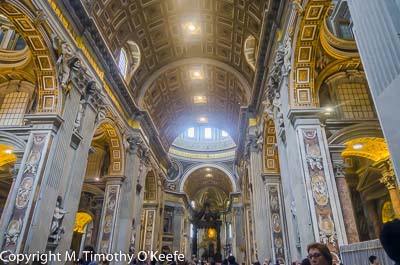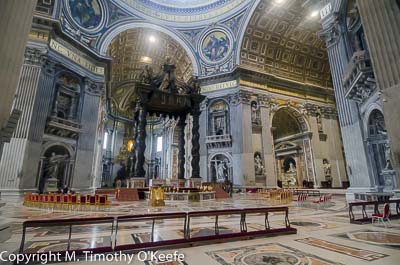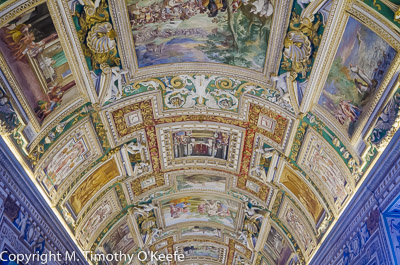Touring the Vatican Museum and St. Peter’s Basilica
On the second day the Prinsendam is docked at Civitavecchia, the port of Rome, the foul weather improves significantly with alternating spells of sun and clouds. It’s also our day for a Prinsendam Rome excursion.
We’re not fans of guided tours but Rome is too big for us to waste time figuring out how to reach every destination before the ship departs at 7 p.m. We join an 11.5-hour that departs at 7 a.m. Unfortunately, it takes us about two hours to cover the 45 miles to the Vatican Museum due to the clogged roads caused by the morning commute. Apparently it can be worse in summer when 14 ships could fill the cruise port.
The Vatican Museum & Sistine Chapel
Although it’s the off-season, it’s hard to imagine how the Vatican Museum ever can be busier than it is today. One of the world’s greatest and most visited art museums, the Vatican Museum was founded by Pope Julius II in the early 16th century. It now houses pieces dating going back to Egyptians and Etruscans but is best known for the marvelous works by Europe’s greatest artists and sculptors.
Once inside, we soon enter a hallway with an endless shuffling column of people looking from side to side to view sculptures and paintings while at the same time craning their necks to see the vivid painted ceilings. The bright ceiling decorations and colors are irresistible for photographers and many of us pause whenever we can to shoot them. Photography will not be permitted later in the Sistine Chapel itself.
Profane Secrets Hidden in the Sistine Chapel
Our guide tells us that Michelangelo, who considered himself foremost a sculptor, was forced by Pope Julius II to paint the ceiling. Michelangelo worked over a four year period from 1508-1512 on the project which was never intended to be open to the public, only to the Pope and other church officials. Our guide says Michelangelo clearly made a mockery of the Pope in many parts of his 12,000-sq. ft. masterpiece. The ceiling panels, which depict stories from the Book of Genesis covering the Creation to the story of Noah, are filled with numerous scenes of joyful nudity that shocked the church.
In addition, there were hidden messages: shapes making up the figure of God are an anatomically accurate figure of the human brain, complete with stem, front lobe and artery. He also shows God’s derriere and the dirty soles of his feet. In the Creation of Adam, Adam has a naval yet he was never born. The Last Judgement, painted much later, is rampant with nude saints, female breasts, animals, buffoons, dwarfs, drunkards and other provocative elements that caused the Sistine Chapel ceiling to be censored. Offending figures were covered with fig leaves or clothed by other artists. It took 300 years, during 20th century restorations, for the alterations to be removed.
Now that we know what to look for in certain panels removes any pious feeling when our turn comes to view the Sistine Chapel ceiling. The room is overcrowded, making it difficult to see the painting well. It is actually easier to view the Sistine Chapel on a computer screen than in person. The Vatican offers a 3-D virtual tour but manage the tour yourself. The autopilot tour moves much too fast. This site loads slowly; it’s worth the wait: http://vatican.com/tour/sistine_chapel_3D
Surprising Facts about St. Peter’s Basilica
 St. Peter’s Basilica, Rome, Italy
St. Peter’s Basilica, Rome, Italy
From the Vatican Museum it’s only a few steps to St. Peter’s Basilica, where there is far more room to move about freely. Well, this is the largest church in the Christian world, able to hold 60,000 people. Our guide has some more surprising facts about St. Peters. First, it is only a church, not a cathedral, since it is not the Pope’s own cathedral. However, because of St. Peter’s size and location, it is used by the Papal authorities for many church functions.
Michelangelo also has major influences here. He designed the basilica’s famous dome, a city landmark viewable for miles around. His famous sculpture, the Pieta, is also located within the church. It is said to be the only work he ever signed. For all it fame, the statue of the Virgin Mary holding the dead body of Jesus Christ appears surprisingly unguarded; it is actually encased in bulletproof glass .
The first St. Peter’s was built here in the 4th century because it was thought to be where St. Peter’s bones were buried. Bones indeed have been found here in recent years and claimed to be those of Peter. Pope Francis in 2013 displayed a box apparently holding the remains during a mass in St. Peter’s Square.
The bones have not been scientifically tested to verify their age nor are they likely to be. They carry a 1,000 year old curse verified by Vatican documents that state anyone who disturbs the peace of Peter’s tomb will suffer the worst possible misfortune. But doesn’t it seem that has already been done by being dug up decades ago and then displaying them in a box in public?
 St. Peter’s Basilica, Rome, Italy
St. Peter’s Basilica, Rome, Italy
The Unexpected Egyptian Obelisk in St. Peter’s Square
Afterwards we wander through one side of St. Peter’s Square located in front of the church. Perhaps the most surprising thing about the huge expanse—besides the sea of chairs used for special occasions—is the presence of a 4,000-year old Egyptian obelisk in the middle of the square. Although it lacks any hieroglyphic markings, that isn’t actually a Christian symbol. Why is it there?
Brought from Alexandria, the obelisk was erected by the Emperor Caligula to mark his Circus where he held horse races. Later it was the site of the Nero Circus, a place were numerous Christians were martyred, among them Peter. When the new St. Peter’s Basilica was built in the 1500s, Pope Sixtus V had the obelisk transferred to the center of the square so it could stand in front of the church. It took 13 months to move and re-erect. It remains standing as the final witness to the martyrdom of St. Peter.
Amazing how these obelisks turn up in so many important places in Europe and the U.S. And wonder why they’ve been considered symbols of power for thousands of years across cultures.
Next: The Pantheon and Views of Ancient Rome.


 Follow
Follow